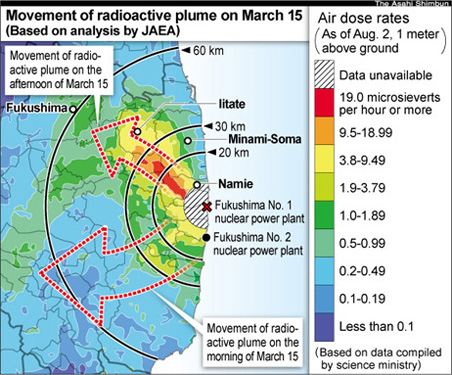Rain To-Blame For March 15 Radiation Spike In Fukushima

Fukushima Power Plant
EMF Protection Devices
Magnetic Field Detector
September 08, 2011 | By HIROSHI
ISHIZUKA
The belt of high-level radioactive
contamination that extended to the northwest of the stricken
Fukushima No. 1 nuclear power plant was the result of
weather conditions on the afternoon of March 15, analysis by
the Japan Atomic Energy Agency has shown.
Rainfall subsequently deposited large quantities of
radioactive substances, discharged from the crippled No. 2
reactor, onto the ground. The contamination levels would
have been much lower if it had not been for the rain, the
researchers said.
The belt extends about 40 kilometers to the northwest of
the nuclear plant and runs through the town of Namie and
Iitate village. The radiation dose survey results, released
Sept. 1 by the government, also showed that zones of high
doses were concentrated in the vicinity of the nuclear plant
and to the northwest of the plant.
In the no-entry zone, the area within a 20-km radius of
the nuclear plant, the maximum dose at a 1-meter height
above ground was 139 microsieverts per hour in the Ottozawa
district of Okuma town, about 1 km southwest of the nuclear
plant. In the planned evacuation zone, designated along the
belt of high contamination beyond that radius, the maximum
dose was 41.3 microsieverts per hour in the Hirusone
district of Namie town, about 22 km to the northwest.
Areas 40 percent the size of Tokyo, or 800 square km,
were contaminated above the threshold level for compulsory
evacuation following the 1986 Chernobyl accident.
Haruyasu Nagai, leader of the Research Group for
Environmental Science at the JAEA, estimated that large
quantities of radioactive substances were discharged from
the crippled No. 2 reactor over two periods: between 7 a.m.
and 11 a.m. and between 1 p.m. and 3 p.m., both on March 15.
During the second spell of discharge in the afternoon, a
cloud of radioactive substances accumulated in gas form
drifted first to the west and gradually changed direction to
the northwest.
It is thought that rainfall then deposited radioactive
substances onto the ground and created the belt of high
contamination. According to the Japan Meteorological Agency,
precipitation of 0.5-1.5 millimeters per hour was recorded
for a duration of about half a day starting at 5 p.m. in
Iitate village.
"Weak winds and slow plume movements contributed to the
high concentrations of radioactive substances, but the
largest contribution came from the rain," said Hiromi
Yamazawa, a professor of radiation-related environmental
safety at Nagoya University.
http://www.emfnews.org/store
|